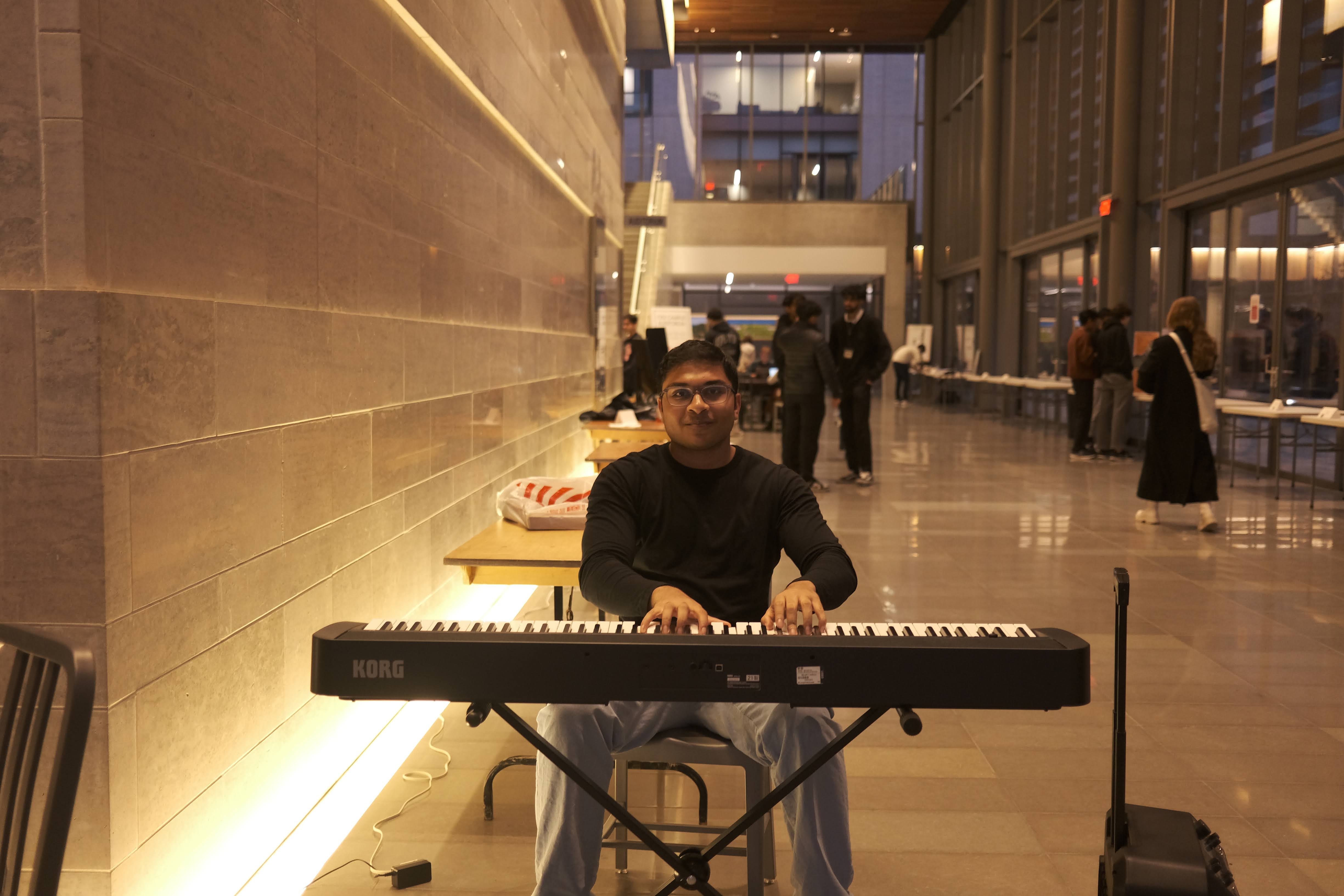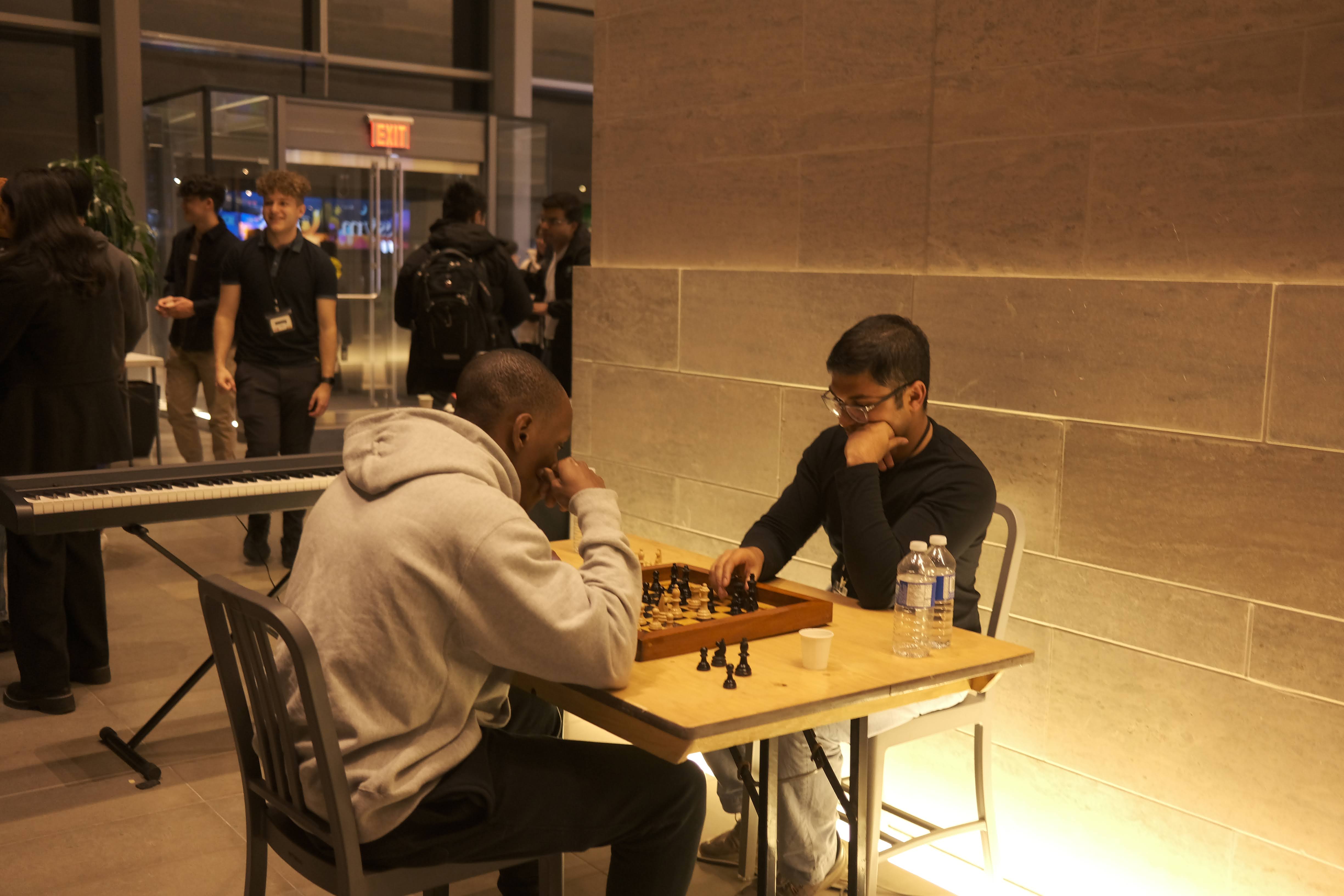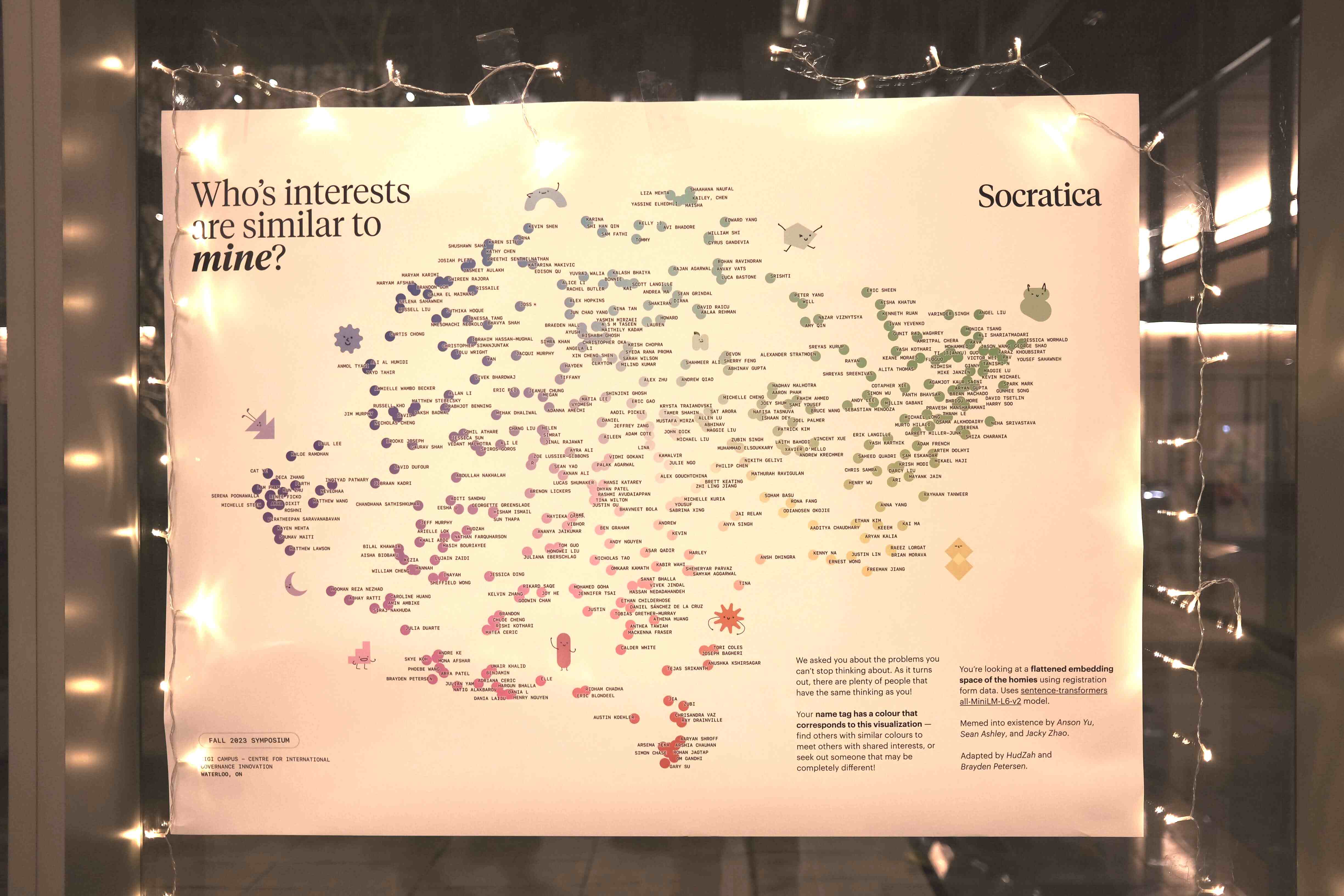The Essence of Demo Days
Written by Hudzah, Donald Jewkes, Kelly Chong, internetVin, Jake Rudolph, and Anson Yu
This issue was written in collaboration with friends from around the world who have run the following demo days: MVD, New Demos, the SoTo Spotlight, the Atelier Showcase, the London Symposium, and the Socratica Symposium.
Bringing an idea to life is best complemented by the opportunity to share it with the world. Demo days provide a platform for communities to collaboratively explore, showcase, and celebrate effortful projects!
They serve to inspire people to lean into their ambitious ideas and invite others to become meaningfully engaged in community. Along the way, there’s a chance to craft whimsical shared experiences that might just make people smile :)
Demos, as a medium, allow for exposition of process. Demoers are able to share their story and give others visibility into foundational parts of their projects that are often hidden behind a final product: intention, problem solving, learnings, narrative, and works in progress.
internetVin: It’s important to note that these events aren’t pitches. There’s a difference between a pitch, which is like “this is why you should give me money,” and a show and tell, which is more like, “this is what I’m learning, or here’s why this matters to me.”
Presenting your work can create ripple effects you cannot predict and there is real potential to kickstart someone else’s project. In return, they get access to environments that facilitate feedback and iteration and the opportunity to find people experimenting with similar ideas. These interactions compound and, in time, we become a series series of playful project collaborators!
By hosting a demo day, you are signalling to the world:
- What the people in your communities care about
- Why they care
- And why others should care too
As opposed to previous issues, some of this advice is very tactical and direct. None of these steps are “perfect” or “mandatory” to run a successful demo day – rather, we are presenting are findings from the events we’ve run so far. We’re actively experimenting with new formats and we encourage you to do the same!
The Core Parts of a Demo Day
1. The People
- Your organizers, volunteers, and demoers. They are your rock and their impact is directly proportional to the success of your event.
- Finding co-hosts who care is essential! We’ve written more on how to find co-hosts.
- You want a swiss army knife of a team, from people who are spreadsheet warriors to people whose sole duty is talking to attendees.
2. The Logistics
- Meticulously coordinating all your logistics sounds boring – but frees up a lot of creative time for your sparkle people who bring the pizzazz to the event.
- This includes food, spreadsheets, proper AV, photography, etc.
- Having agentic people who just get stuff done in this role is usually a good tip!
3. The Sparkle
- The parts of the event that make it feel like magic. It’s hard to make a tutorial on “how to make something sparkle”, but here are some things that have worked for us:
- Do things that make you chuckle when you think about it or you find amusing or want to exist
- Adding sparkle to an event is a skill that takes practice. Start small (make an Instagram story that is funny to you for your event).
- The most important part is that you have fun with the sparkle ideas - if you don’t have fun with them, no one else will either.
- Work with sparkly people
- Some examples of sparkle at demo days have been:
- Clip on zines at Vancouver’s Minimum Viable Demos
- Bougie pizza
- Piano player stationed in front of the entrance
- Matchmaking map at Waterloo’s Symposium
- Beef patties at Toronto’s New Demos
It’s the little sparkly things that compound to make your demo day feel inherently unique – they are usually highly experimental and may completely flop, but they’re unforgettable when they don’t!
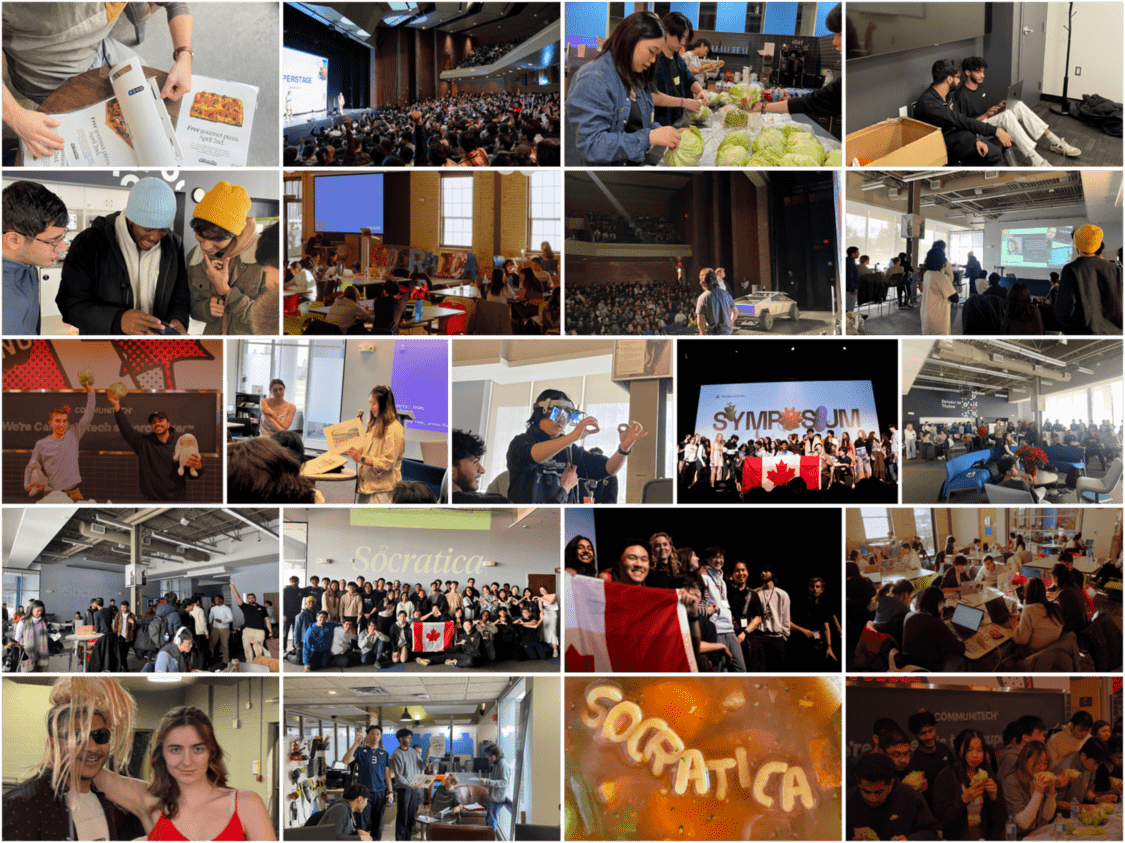
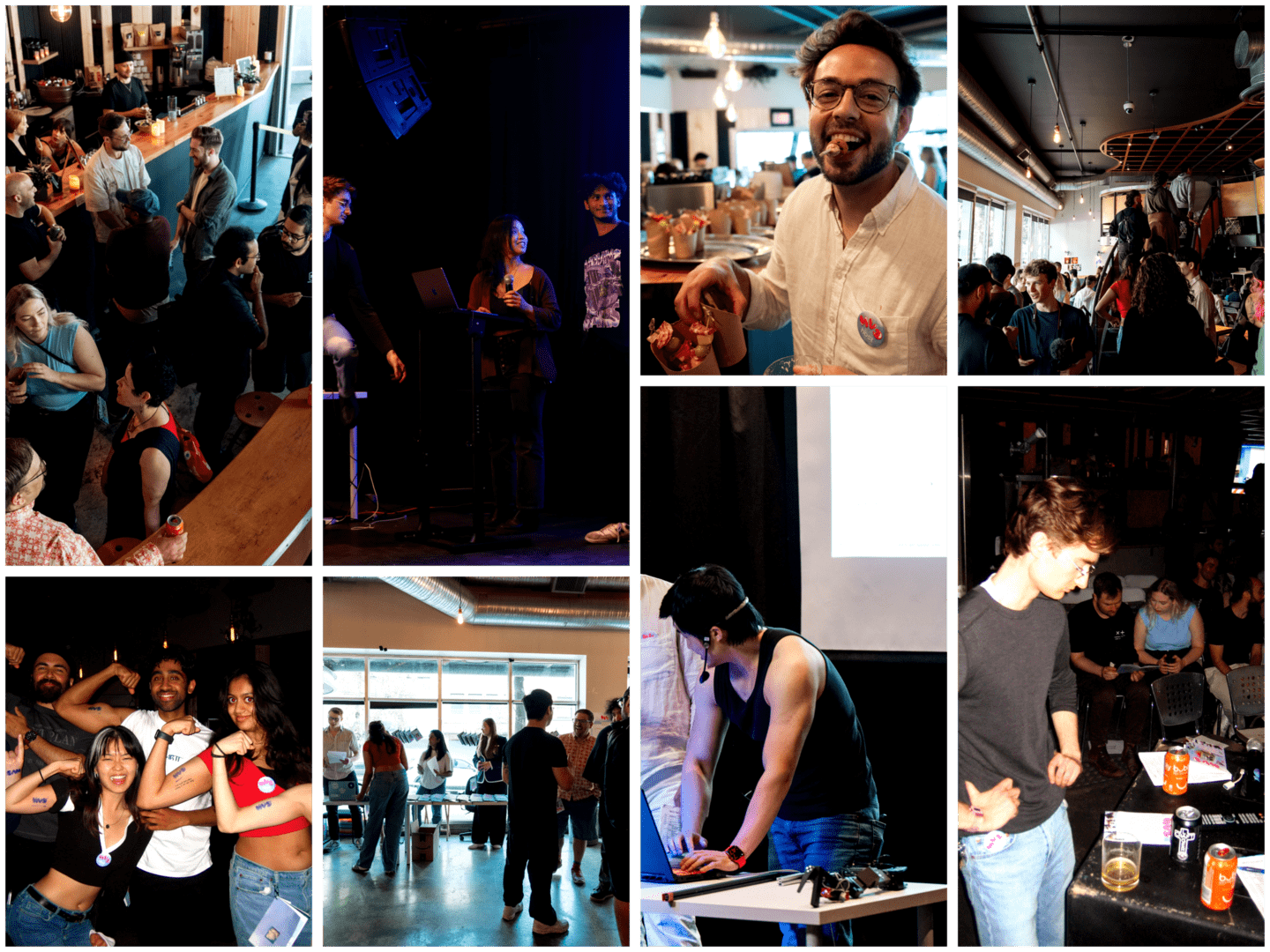 Photos from Minimum Viable Demos and Socratica
Photos from Minimum Viable Demos and Socratica
How to Find Demoers?
Written by Anson Yu, Donald Jewkes, Kelly Chong, internetVin, Jake Rudolph, and Hudzah
There are two approaches to “discovery”:
- Picking the fruit
- Growing it
Note that finding demoers, and having them feel confident or comfortable enough to demo are two different things.
Picking the fruit
- This could be you
- This could also be your friends
There are several ways to pick the fruit:
-
Proactive identification:
- Proactively identify people with intriguing projects by attending co-working sessions like Socratica/Atelier/SoTo to demo at the symposium.
- See more on how to find the people that are trying to find you
-
Your community:
- Sift through anyone who signs up for your event or who interacts with your online presence. Nurture and grow connections early and reach out to them to see if they are interested in demoing.
- Many people who are only peripherally engaged in active communities are working effortfully on projects. Oftentimes it only takes a small dose of belief capital to have them become excited about demoing.
- Sift through anyone who signs up for your event or who interacts with your online presence. Nurture and grow connections early and reach out to them to see if they are interested in demoing.
-
The people around you:
- Maintain a dynamic list of potential demoers and ensure it is continuously updated and curated. Always be on the lookout.
- Letting friends contribute to this private list somehow too. Making yourself, or an anonymous organization a beacon.
- Going on walks with people, asking for referrals, putting in the time to earn the trust of potential demoers in hopes they’d trust me to help showcase their work
- Finding one awesome person, then digging into their affiliated organizations - awesome people tend to love being around other awesome people!
- Maintain a dynamic list of potential demoers and ensure it is continuously updated and curated. Always be on the lookout.
-
Your brand:
- Putting out things yourself, being publicly creative to attract other creative people
- Finding things to work on is tricky, but we’ve written about it! See how to choose what ideas to work on
-
Continuous improvement:
- As you ship demos events successfully, this gets easier. It was easier to get demoers for New Demos 2 than it was for New Demos 1, and I imagine New Demos 3 will be easier than New Demos 2.
- That being said I wish there was a better way to handle this, it seems like it’s one of the hardest parts about consistently doing demo events, you have to really be disciplined about continually seeking out people working on interesting things, chatting with them, understanding their visions etc.
Growing the fruit
- See how to superboost ideas
- If your demoers are people who are not used to presentations, you can assist them by having a team of helpers create (or source) a set of guidelines or pitch deck templates to guide them
- Ex. at Soto Spotlight, we had volunteers individually work with demoers to craft their demos, had dry runs where we gave feedback, and overall aimed to make them feel good for demo day
How to Plan Logistics
Written by Seneca Forster, Ananya Kannan, and HudZah
We can break down the logistics of a demo-day into 3 core parts: the pre-event, during event and post-event. Planning your event depends on the scale of the event. The first ever symposium was pulled off in 2 weeks and last symposium was a multi-month ordeal.
Pre-Event
Registrations
- Make a registration form, this will help cap the number of attendees and collect info on who comes. We use luma to do this.
- Examples of things to ask:
- how they heard of the event
- accommodations
- dietary restrictions
- Invite people who’d love to come but need to make additional arrangements early (people from other cities, demoer’s, family etc). A personal message goes a long way.
- For paid events, it could be useful to offer a free ticket for VIPs and guests that are part of underrepresented groups. The most important people (VIPs) are the ones who show up (all of them!) - and that’s where the most attention and focus should go
Venue
- Choose a well-equipped venue that matches the event’s vibe.
- Potential spaces: galleries, studios, community centres, auditoriums, university rooms, cafes, conference rooms, etc.
- Each space gives a different atmosphere (e.g. a cinema gives a much more theatrical feel to the demos, while a conference room in a university feels a little more scrappy and exploratory). Think about which venue fits most with the demos planned.
- Consider partnering with these venues or asking them for sponsorships! For more on finding sponsorships, read how to fundraise
- We wrote more on how to organize spaces that feel awesome
A poster from NapYork – a hostel for sleeping in NYC – that I think did a great job at thinking about the vibe of a space in relation to your senses. This is a great framework for thinking about the vibe of a space:
- See: Does the space look clean?
- Smell: Does the space smell good? Does the food smell good?
- Hear: Is the music playing?
- Feel: Is the temperature good?
- Taste: Are the condiments stocked? Is the food good?
- Common sense: Use it when things go wrong.
Audio/Video
- The event feels most magical when all the tech works - prioritize having reliable AV, clear communications and checklists beforehand
- If there’s a demo that may have technical difficulties with audio/video, schedule a test run with the demoer beforehand - i.e. VR developer, videographer
Having checklists for everything is so ridiculously helpful. In Poor Charlie’s Almanack, Charlie quotes “No wise pilot, no matter how great his talent and experience, fails to use a checklist.”
Food
- People love good food. Maintain high standards of hospitality with quality food and refreshments.
- Be sure to take dietary restrictions into account. Common dietary restrictions to consider: Vegetarian, Vegan, Halal, Gluten Free, Dairy Free, Kosher, and Common Allergies (Nuts, Sesame). It would be useful to ensure at least one or two of the food options can fit into each of the above.
- Pizza is usually the best food because its easy to hit all of these
- Take these restrictions into account in your registration forms
- People are most happy when food arrives on time – or early!
Rehearsal
- Optionally, have a rehearsal 1-2 days before with hosts (and potentially demoers who have more logistically complex demos) to review event structure, tech system, and set up
- Email demoers about the event schedule, demo structure, and demo lineup so people know what to expect. Here is an example of the demo information package we created for MVD.
- Be clear on the time restrictions on the demos, and let the demoers know that you will cut the demo short if they go over time.
- Think about transitions between 1 demo to the next. It depends on the values of your event, but how will 1 demo end, and the next one begin. I don’t think there’s a right or wrong way to do this, depends on the effect you are going for, but I think that the transition should be a conscious choice and not something left to chance.
During Event
Check-in
- Have a check-in table with name tags and registration
- It’s useful to have a printed copy of the people who signed up on hand in case of technical difficulties.
- Have music playing at the start as people walk in and screenshare a welcoming slide/visual as guests arrive
- Print and post signs directing to the venue, for bathrooms, food etc.
- Have dedicated roles for check-in, these are people who greets guests as they arrive, registers each attendee and provides event info
Demos
- Set a visible timer for demos, such as on a laptop facing the presenter
- Facilitator/MC: Speaks before and after demos, announces breaks and transitions, keeps the crowd warm during demo setup/takedown.
- Think about how to transition microphones and props on stage, if needed have backstage roles on standby who are ready to help move things on stage and help demoer’s. This supporting role can also coordinate demo order, briefs demoers on details during the event. Useful if this person is also the point person for demoers before and shared the info package prior.
- Have someone on standby at all times to handle technical issues as they arise.
Other
- All-purpose runner: Have someone on standby to fix any logistical issues
Post event
- Send out a feedback form using Google Forms or Tally
- Tear down / clear up (bringing a spare garbage bag or two never hurts)
- Send out a Notion page, doc, or zine of each demoer’s contact info
- Document where things went wrong and areas for improvement! It’s valuable info to look back on and to share with others, including in this Toolbox.
How to Craft the Sparkle
Written by Donald, Seneca Forster, Xiao Da, Clo Wang, Ananya Kannan, and Hudzah
Demo days are unique in being a canvas to craft a magical experience for others. Strong logistical foundations are required – but it’s the experiments you choose to run that will create something truly transformative for those attending.
Sparkle is not something that can be architected; one can only create the conditions that will allow for sparkle to occur. It’s the job of hosts to line up the pins to fall rather than to take the shot.
Finding cultivators
It seems that sparkle most often emerges from giving people a platform to shine. Some signs that a person might be a strong cultivator of sparkle:
- They are motivated by gift giving – perhaps they crochet beautiful animals for their friends.
- Their work is informed by deep empathy for those on the receiving end.
- They love to fully commit to an ambitious idea and see it through!
- They have executed elaborate, pro-social pranks or schemes.
Listening for the signs
Sparkle is a shared experience that slowly evaporates after an event. There is no sense trying too hard to capture it, better to fully enjoy it while it lasts! The best indicators of sparkle are often feelings:
- Someone poured themselves into crafting this experience for me.
- All stones turned unveiled a bundle of effortful intention.
- We were a part of something truly new.
- We formed a deep connection <3
- This was truly memorable.
Effortful intention begets effortful intention. Strong feelings compound and sparkle blossoms in favourable group environments. Many of the strongest examples of sparkle lay the infrastructure for meaningful connection and invite people to feel part of the community. Guide people to each other, make everyone feel welcome, and create opportunities for people to get involved during the event.
Live experimentation
Experimental demos are a great way to explore creating the wow-factor of a theatrical experience. These often pose operational risk, but the upside is quite large. Test early and create rigourous backup plans.
“Live demos are the holy grail of robotics” – Lingkang
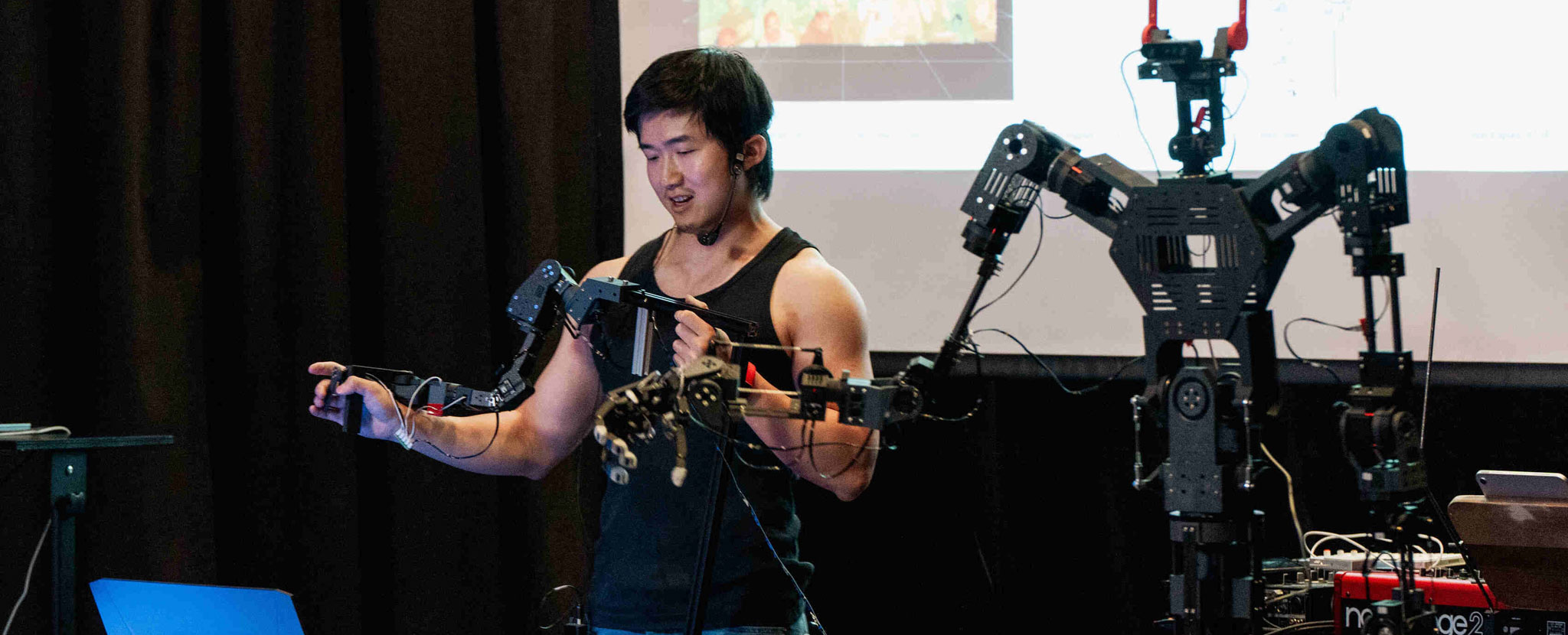 Dual arm humanoid robot mounted to a table and brought on stage at MVD
Dual arm humanoid robot mounted to a table and brought on stage at MVD
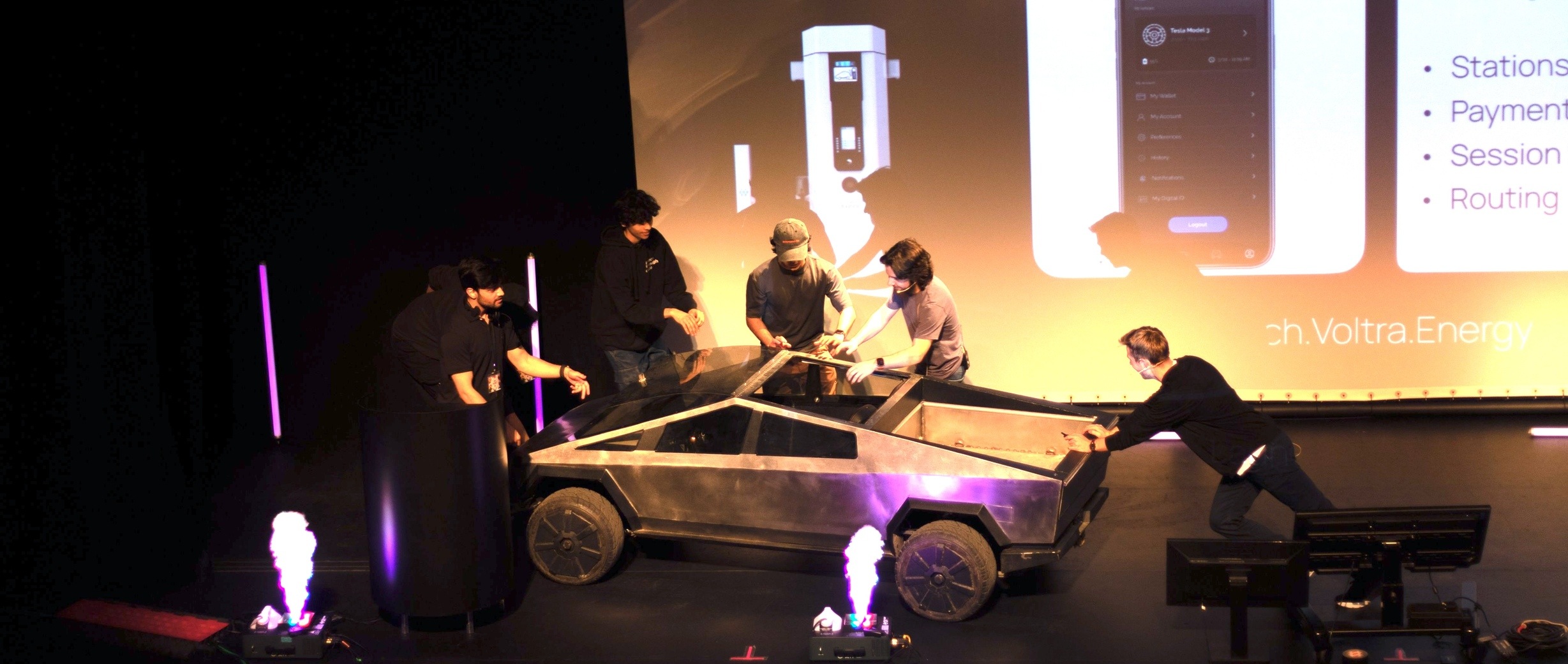 Half-scale Cybertruck at the Symposium: A replica that became a popular photo spot
Half-scale Cybertruck at the Symposium: A replica that became a popular photo spot
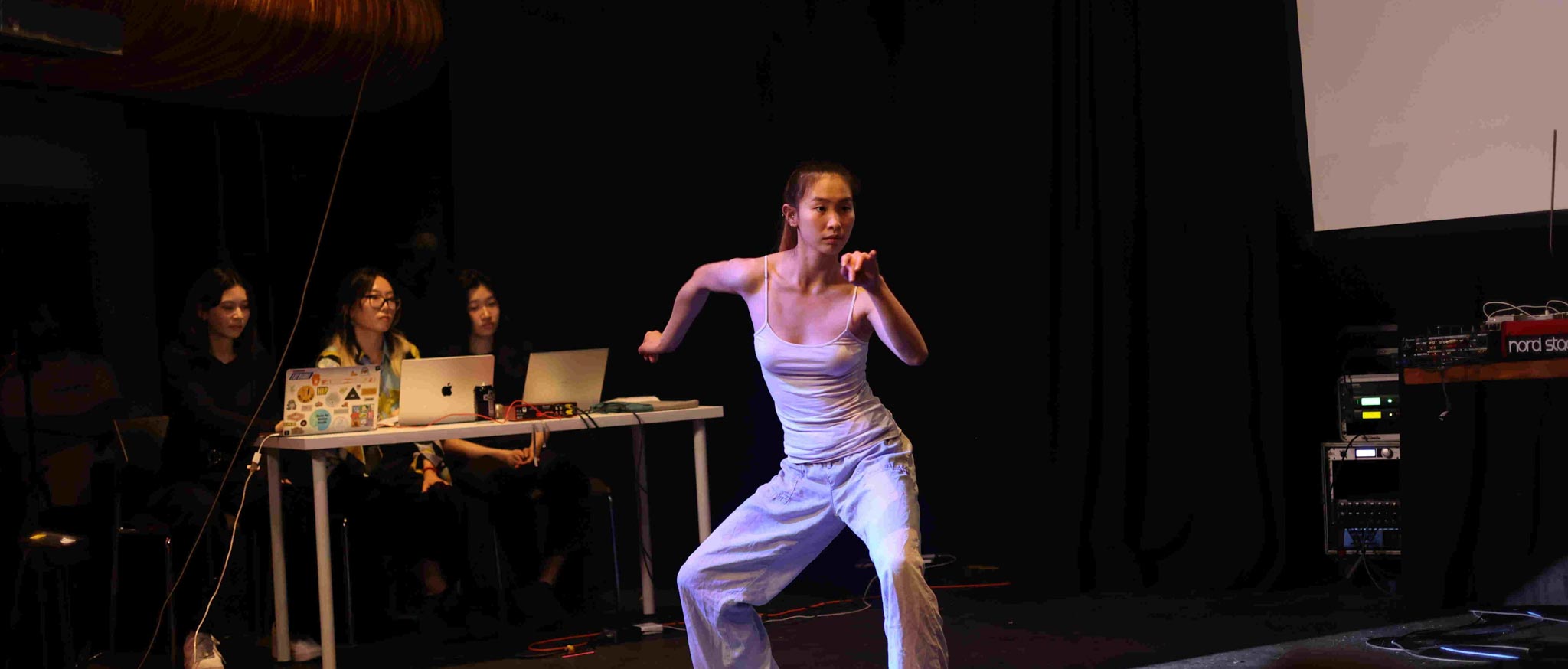 Interactive dance demo at MVD with audio and video features synced to movement
Interactive dance demo at MVD with audio and video features synced to movement
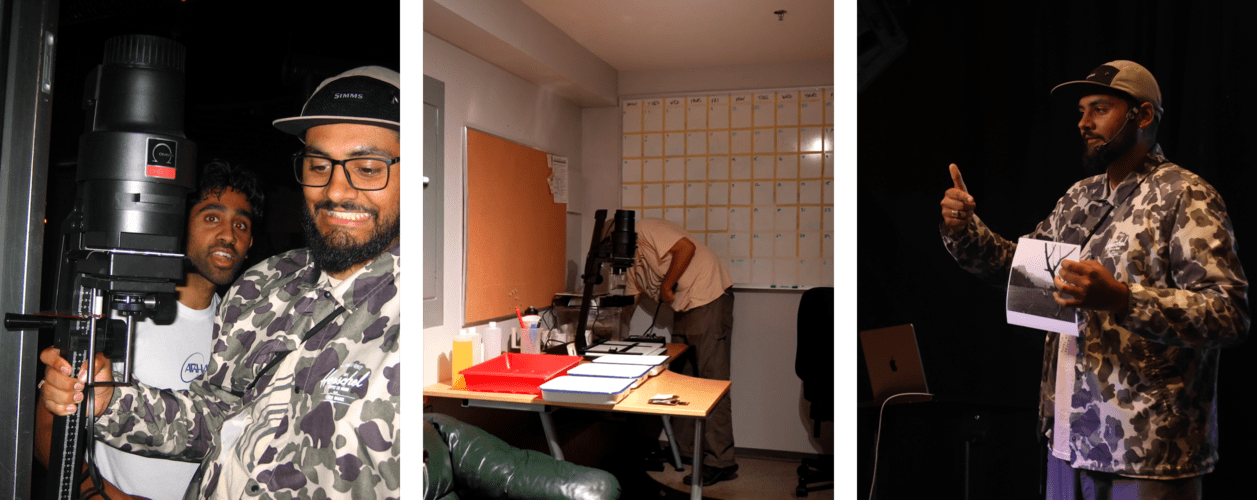 Recreation of a darkroom for film photography printing; projected live for a demo at MVD
Recreation of a darkroom for film photography printing; projected live for a demo at MVD
Surfacing artifacts
Much of the room for experimentation lies outside of demos. Supporting features of demo days can be invented from the ground up – it’s here where the largest opportunity space exists for crafting sparkle!
-
Matchmaking – connecting attendees based on shared interests collected from sign-up forms → past attempt not executed properly but has promising potential to create sparkle
-
MVD Zines – attendees received 32-page booklets that included event programming, a demo list, and writer & artist features.
- Zines served as a tool, an initiation, and a memorable artifact of intention and beauty. This set the stage and served to emphasize: “We are about to be part of something special.”
- Effortfulness was balanced by pages dedicated to “popping the trunk” on artists’ works in progress and the underlying process of bringing MVD to life.
- Hole-punched corners and s-biners emphasized utility.
- Different aesthetic explorations across page spreads were analogous to the heterogeneity of people, projects, and ideas at MVD.
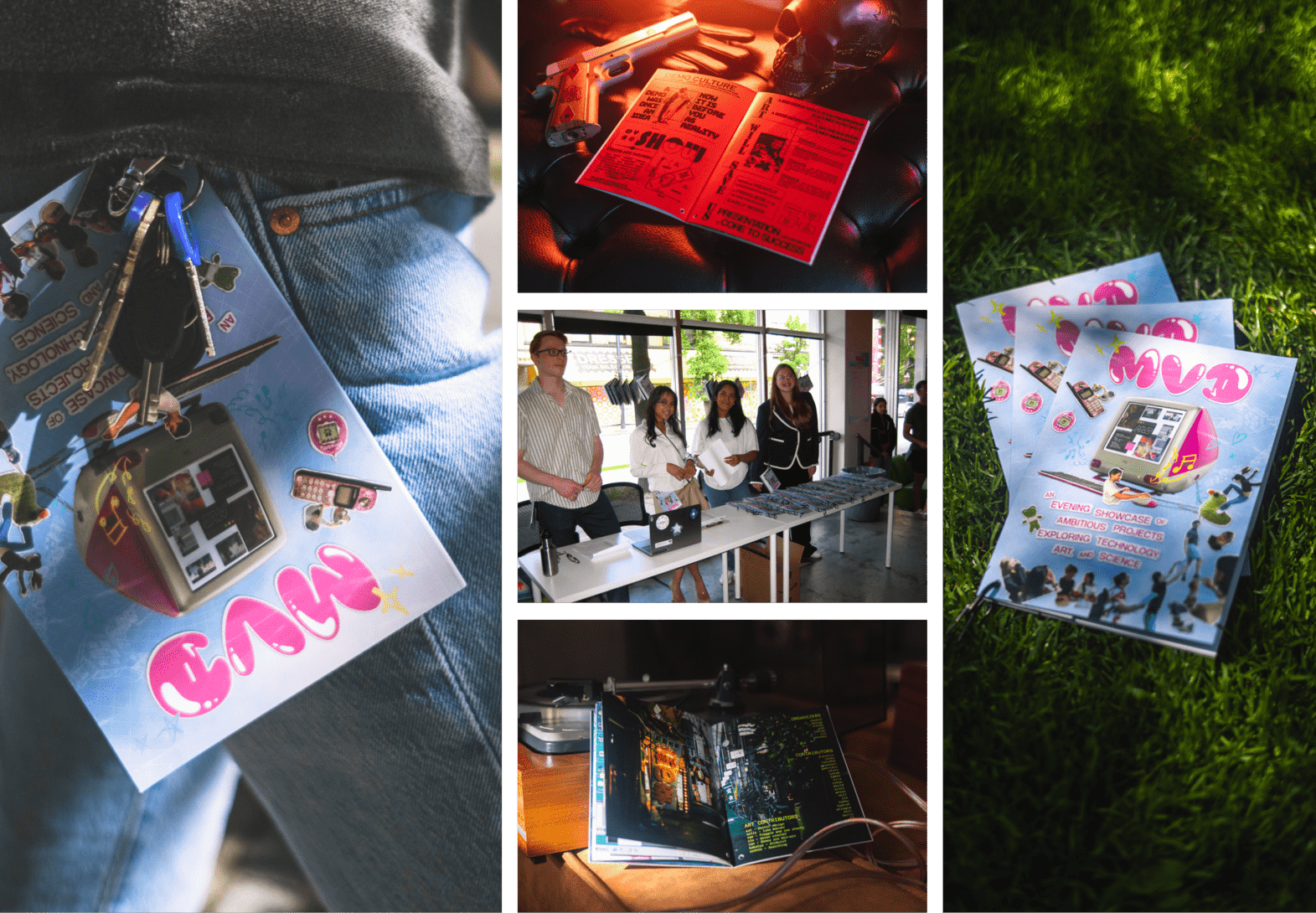
-
Artist features – Showcasing artists’ work creates opportunities for exposure in addition to creating a beautiful experience for attendees.
- MVD experimented with making the space look and feel like an art gallery – in doing this, it’s best to give artists space to speak about their work.
- Symposium had features as part of booth demos, this allowed for more intimate conversations with artists.
- Adding artist cards with names, descriptions, and contact information communicates legitimacy and intention.
- Extra sparkle can be had with usage of monitors for dynamic digital instillations.
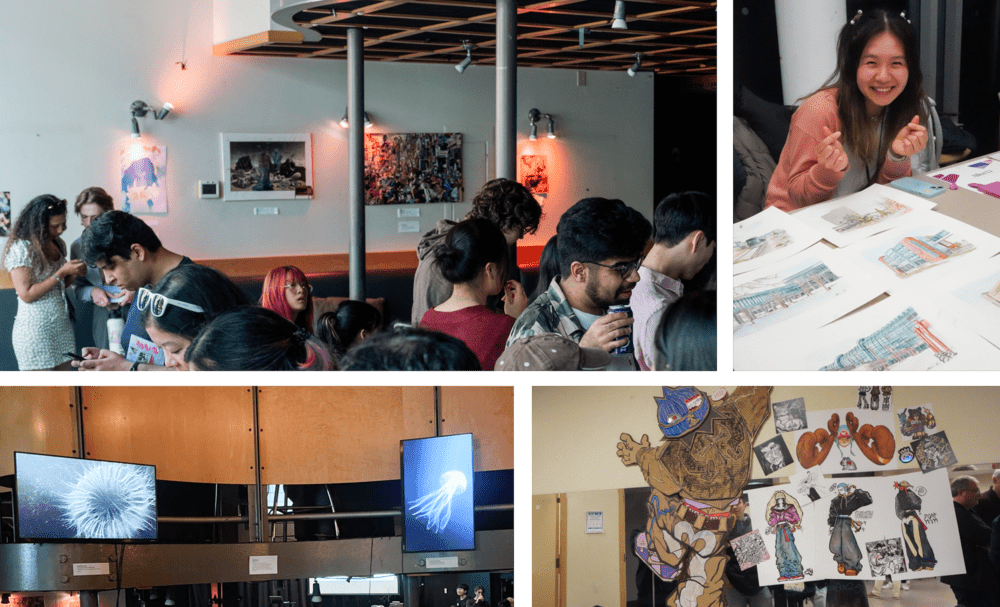
-
Inviting contributions – create opportunities to participate in storytelling and worldbuilding; give people a chance to craft the narrative.
- Recruit people make guiding decisions on how to set up pieces of the event (art placement, posters, chairs, etc.)
- Making Kirbys out of post it notes together.
- Large collaborative art pieces e.g. “I love Vancouver because” or Symposium Mural.
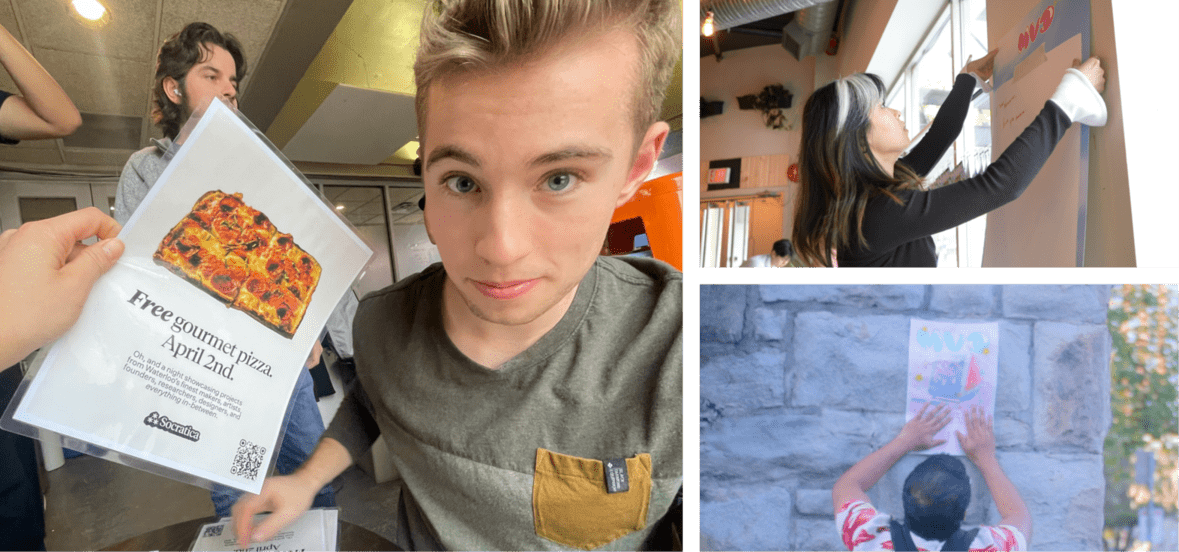
-
Going the extra mile – doing the work to nail your foundations will give you a huge lift through the rest of the event! e.g. food, signage, seating, lighting etc.
 Handmade pizza and charcuterie plates
Handmade pizza and charcuterie plates
Custom Socratica letters: a colorful, 3D photo backdrop that brightened up the venue.
-
Pushing the boundaries – there are no rules in games of whimsy! Stretch your imaginative capacity to add sprinkles of absurdity :)
 A lettuce-eating competition at Socratica Design-a-thon: a hilarious shared experience
A lettuce-eating competition at Socratica Design-a-thon: a hilarious shared experience
 An opera singer, a sea shanty, and a bespoke song at performed at MVD
An opera singer, a sea shanty, and a bespoke song at performed at MVD
Reflect and iterate
Experiments in sparkle are best punctuated by celebration, reflection, and documentation. Everyone wins when more surface area is covered and good ideas get recorded. Sometimes labelling will be hard. It’s still good to keep a log, even if only for personal calibration. Next time you successfully create conditions for sparkle, we encourage you to capture them here!
How to Demo
Written by Hudzah, Brooke Joseph, Jake Rudolph, Shahan Nedadahandeh, and Joy He
Demos can be done in different ways, and traditionally the presentation demos stay consistent. We also include a science fair booth style at the Symposium
- Presentation demos (~4-5 minutes long): showcasing your inspiration, current progress, and vision. Your project doesn’t have to be complete or polished for you to demo, but your presentation should be! We look for people who are passionate, thoughtful and are putting in the effort.
- “Science fair” booths: where you can continue showing off your projects to smaller groups at a time, and have more in depth conversations about your project and goals!
Presentation demos will also have a science fair style-booth as well. There’s also a dump of past demo day presentations and slides at the bottom of this for your reference!
On Stage Demos
It’s necessary to remember the audience that you are presenting to, unlike most presentations that you may have done, this isn’t for a school assignment, a pitch competition or to sell a product. The beauty of demo days is that you can showcase the intricacies, the behind the scenes and the grind behind the seemingly “overnight success” of your projects.
Not all project’s are long term projects either! They can be:
- stories about a greenhouse company you once built and sunsetted,
- a short stint in learning how to play the guitar,
- or even a poem that you’ve been secretly writing in your Notes app.
Believe your work stands on its own without needing to rely on clichés or big claims to try and sell it. Go into the nerdy details of your work. Show the passion, the cool/uncool details that you sweated over. Show exactly what you know.
Also relevant, but more related to co-working session, how to hold great demos
Tips for helping someone improve their presentation:
- Presenters have spent hundreds of hours on their projects, so to them it’s easy for them to miss obviously confusing parts or boring parts of their presentation. As a neutral observer, you’re in the perfect place to find these places and let them know! The goal is to make the presentation as engaging as possible to an audience who has never heard about their story. So look for parts of their presentation that make you confused or bored when they rehearse their demo for you, make sure to note this down and let them know.
- Encourage the presenter to find a coherent narrative about their project. For example, a series of drawings could be presented as a story of one’s journey through life, with each drawing being a stopping point.
- As a presenter, it’s easy to get attached to every paragraph and every slide. As an outside observer, don’t be hesitant to suggest removing the parts that are less strong in your eyes. Cut the fat!
- Encourage the presenter to perform their presentation as naturally as they can, without writing and memorizing a strict script. If they must, encourage them to put high level bullet points of what they want to say for each slide on cue cards. Presenters who think they need pages and pages of flashcards often will realize they don’t! This is because they are presenting their own story and projects, for which they already know the ins and outs of.
Past presentation demos
Here’s a quick overview on some of our favourite demo’s during past Symposium’s and why they captivated the audience.
- Slam Poetry by Joy - Joy’s took an interesting approach with her slides and made them using Figma! Her incredible and unique visuals – mixed with heartfelt words struck a chord with the audience. It reaffirmed the audience’s belief in the potential of art to humanize experiences foreign to their own.
- NeRF and Gaussian Splatting by Shahan - Unlike other demo’s Shahan’s was unique in how he went straight to the point. His quick and highly visual slides kept the audience engaged and their attention completely locked in. He took away complicated concept’s, technical jargon and explained them in the most simple manner thereby not boring the audience. Not to mention, that he was extremely funny and kept things light and humorous!
- Unstuck by Anson - Anson kept her demo intriguing and scrappy. Once again, showing a ton of photos and commentating over them herself. She also showed the culmination of her entire 4-month journey by showing the trailer to her documentary live. Showing off sketches of her thoughts, screenshots of dm’s, memes, her video editor crashing (and other mishaps) brought an element of scrappiness that felt so much more human than other presentations people have seen and truly made it unforgettable!
- Portal by Rajan and Ian - Rajan and Ian showed off their LLM portal with a live demo on stage. Encapsulating the phrase “show not tell” and had the audience in awe with a live working product. They bounced sentences between each other eloquently and it was evident that they had practiced how the duet would work together several times beforehand!
Booth Demos
A successful science fair booth captures the attention through interactive and kinetic elements. Ideally, have something that people can DO at your booth. Certain projects like writing, videos, poetry and harder to make interactive; but, you can get creative. If you’re an artist you could display some of your painting and also have a collaborative canvas that people can add to at your booth. Or you yourself could be a hub where people come to, to talk about similar work, your journey etc.
Think “Science Centre” type of interactivity vs. “Museum”
Past booth demos
Every on-stage presentation demoer also gets a booth! Here are some of the audience’s favourite booth demos in the past.
-
Lina face paint: Lina would paint people’s faces live!
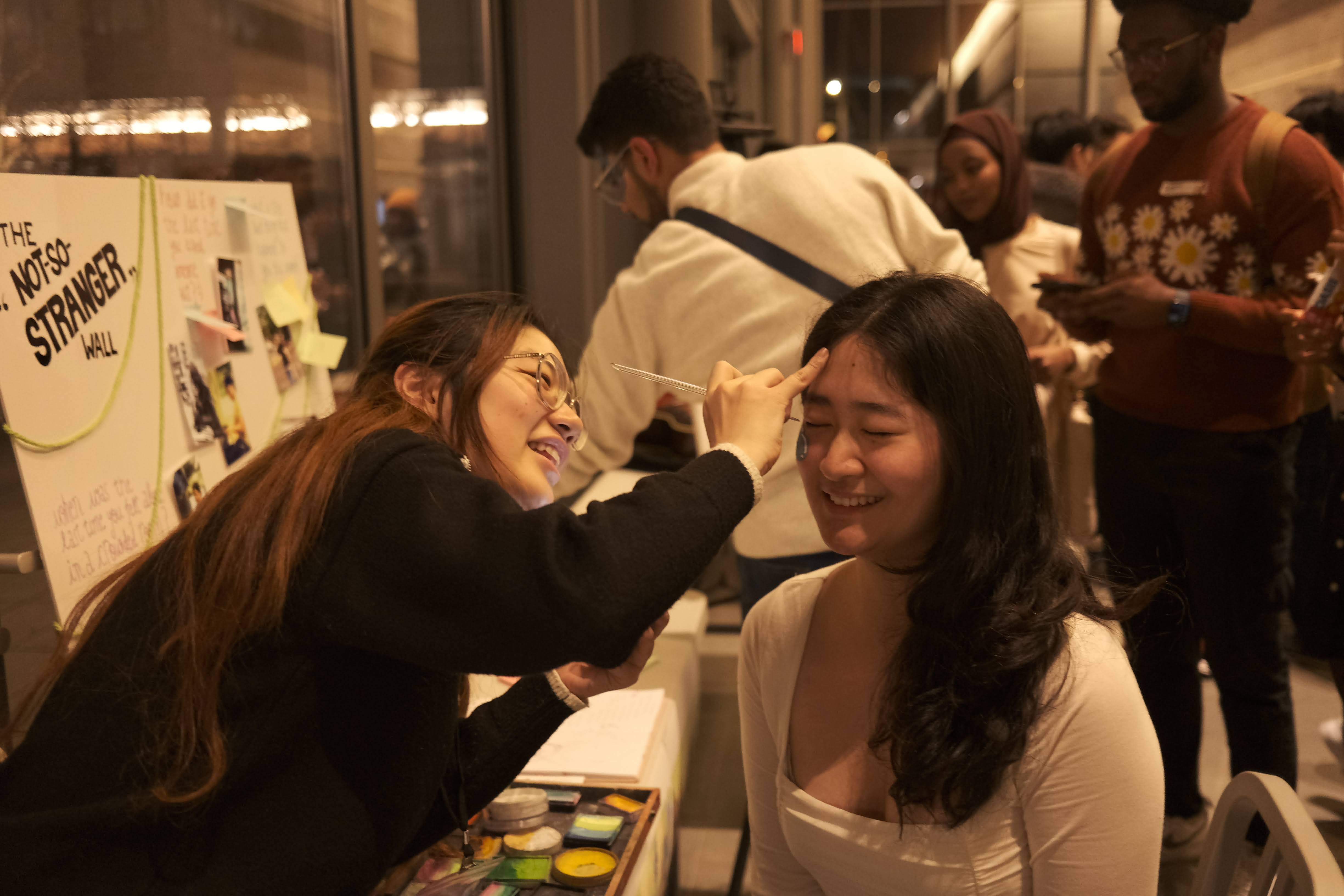
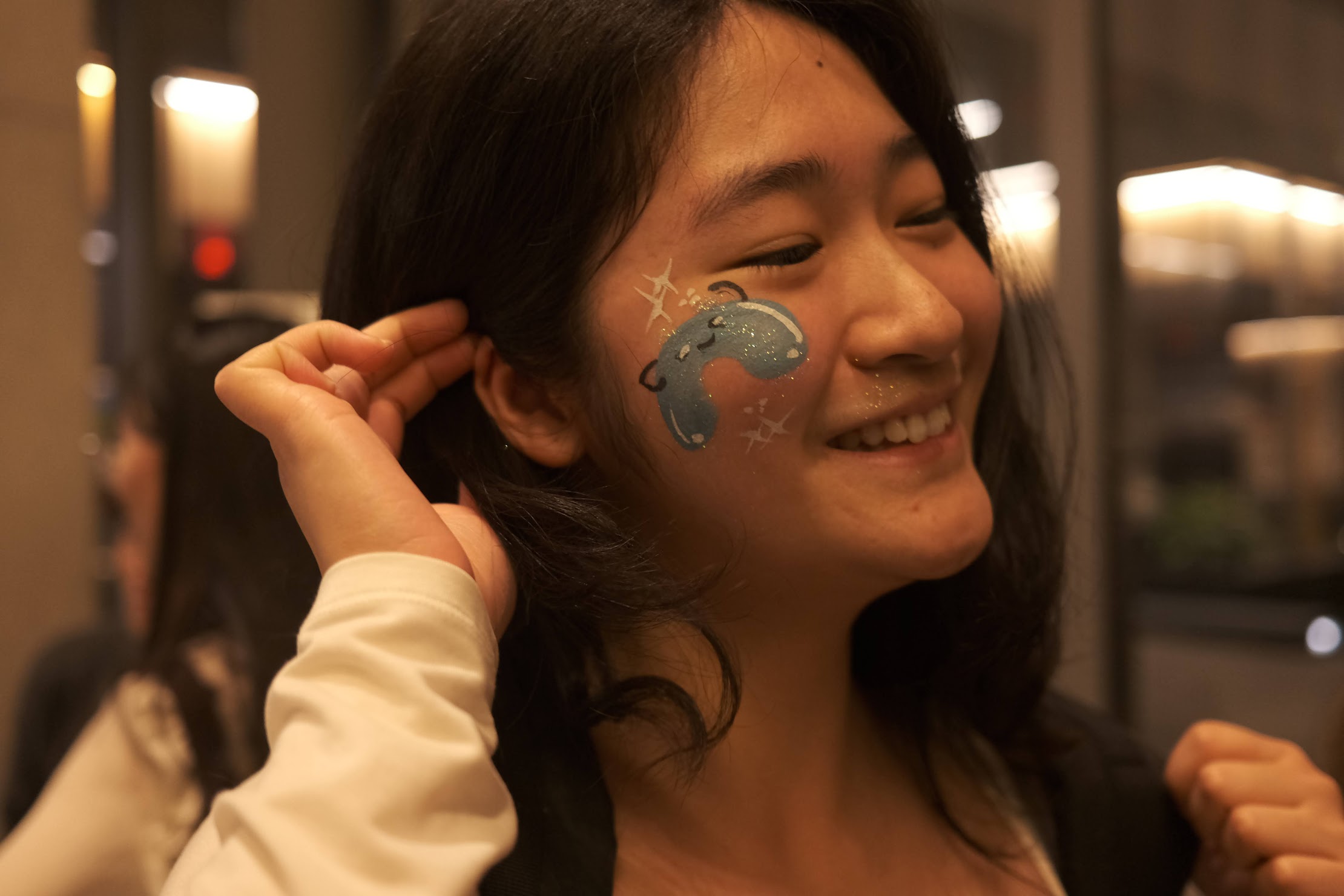
-
Mulei’s Duckweed popcorn - Mulei used duckweed and turned it into a high protein popcorn that tasted delicious!
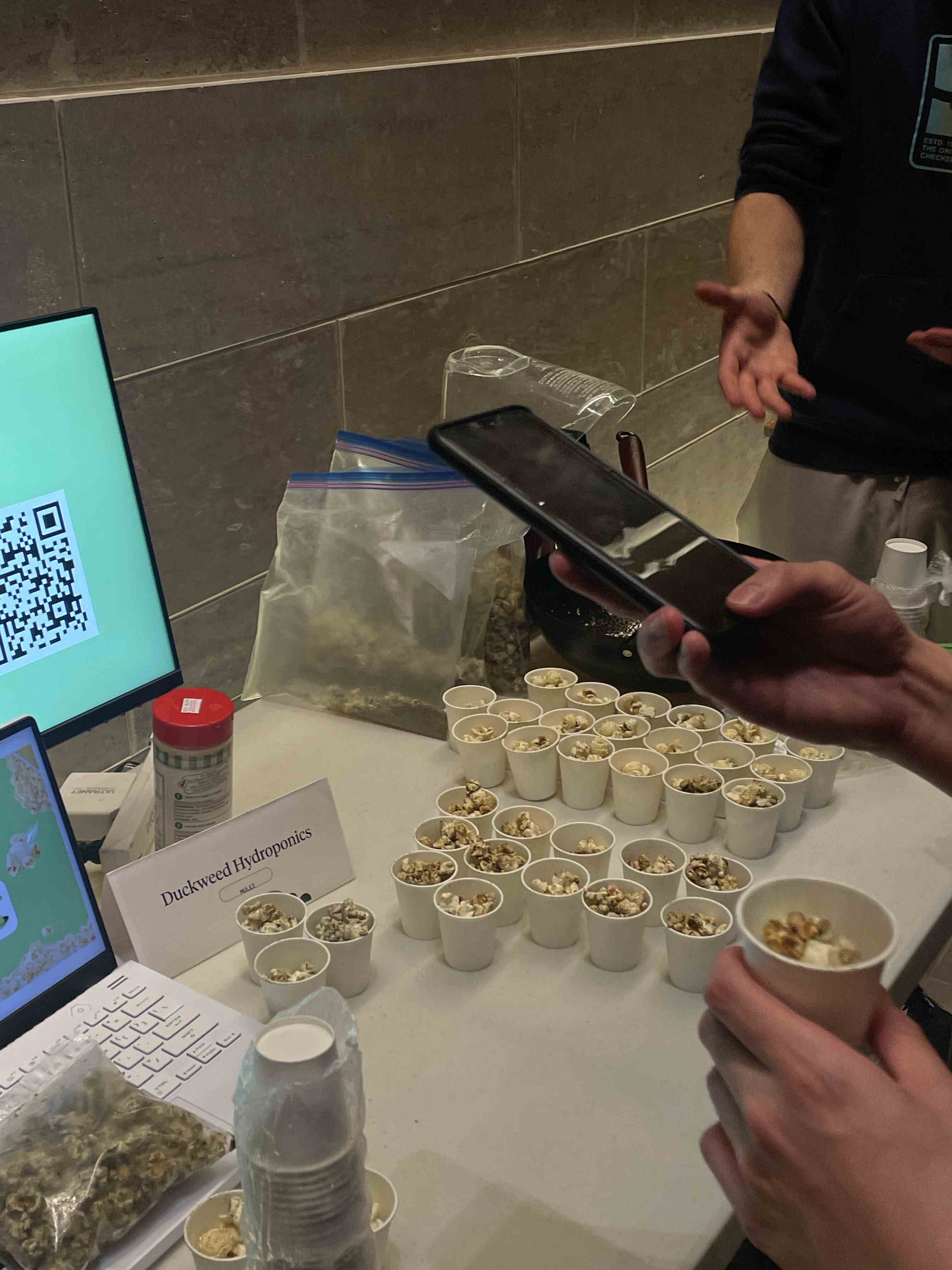
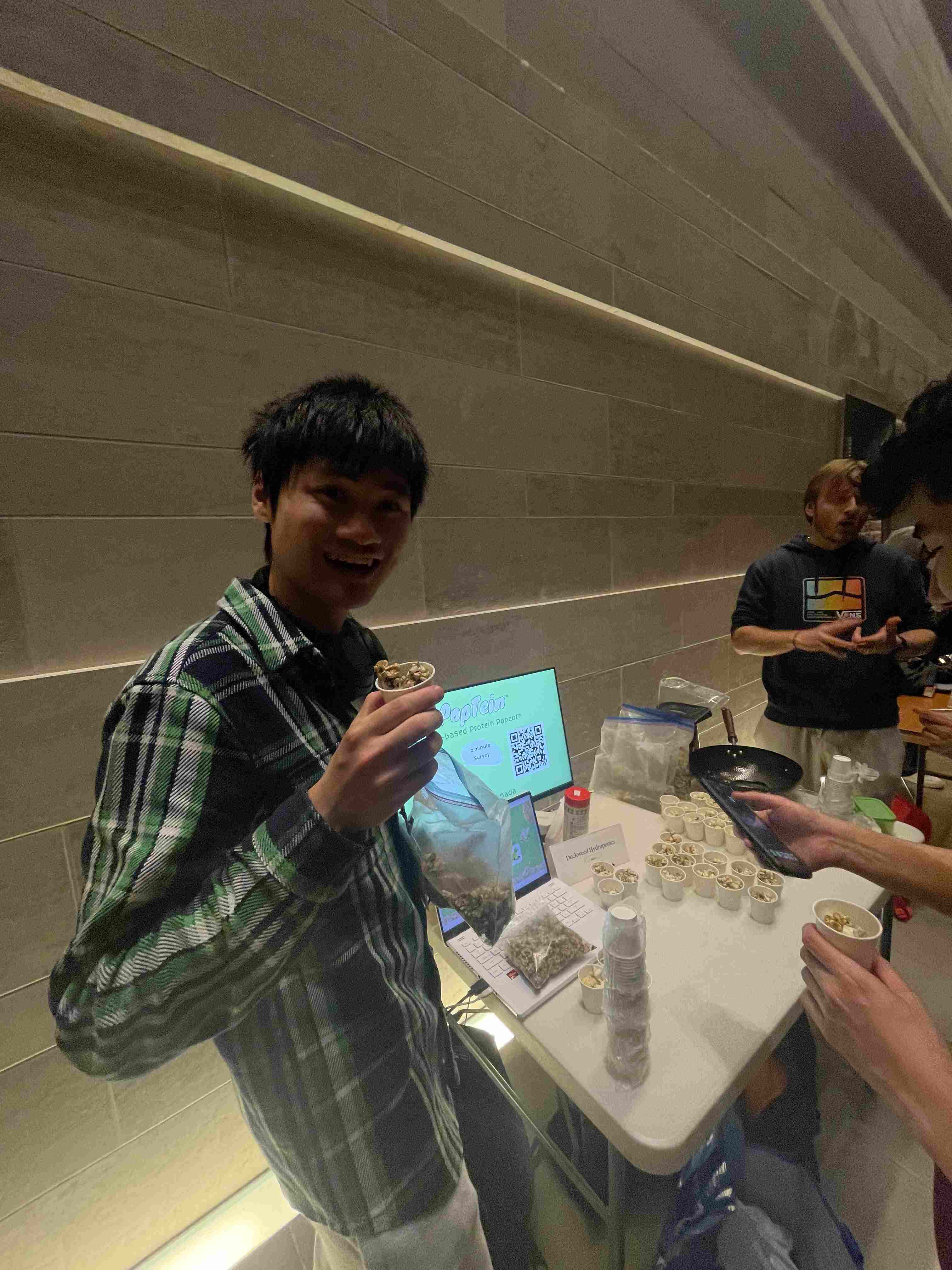
-
Soham’s Piano + Chess - People heard live music as they entered the hall, and they were able to play him in chess!
